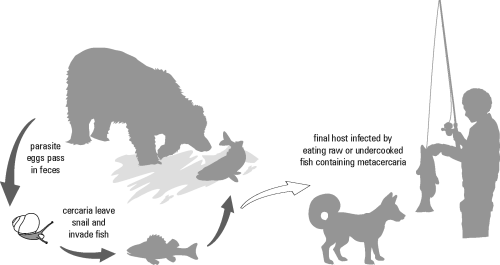| | When well cooked, most fish are safe to eat. However, there are risks associated with eating raw or lightly cooked fish, and the consumer should be aware of them.
Human infections by parasitic worms in edible fishes in Canada are rare. However, the following article describes a parasitic flatworm, the North American liver fluke Metorchis conjunctus, that has been a serious problem in sled dogs in Northern regions and is now emerging as a potential health risk to humans.
Life Cycle of Metorchis conjunctus
Metorchis conjunctus is a parasitic flatworm, commonly called a fluke, that lives in the bile ducts or gall bladder of fish-eating mammals.
The adult fluke produces eggs that pass down the common bile duct to the intestine and are excreted in the feces. Eggs entering fresh water and eaten by an aquatic snail, Amnicola limosa, hatch and release a larva that burrows through the snail's intestine to the liver to continue its development. New larvae, called cercariae, are produced. These larvae leave the snail and swim freely in the water.
When cercariae contact a suitable fish host, they penetrate its skin and encyst in the muscle. The encysted larva is now called a metacercaria. When infected fish are eaten, the metacercaria excysts, and the young worms migrate up the bile duct to the liver where they develop and begin passing eggs in approximately 28 days (Figure 1).

Figure 1. Life cycle of Metorchis conjunctus
What Kind of Fish-Eating Animals are Infected?
Metorchis conjunctus infects a wide range of fish-eating mammals including bears, wolves, foxes, coyotes, raccoons, muskrats, mink, fisher, dogs and cats, and occasionally, man.
This parasite has also caused mortality in sled dogs in northern Canada.
Can All Fish be Infected With Metorchis?
Metorchis occurs most often in the white sucker, but it has been reported occasionally in other fresh-water fish including yellow perch, northern pike and brook char.
How Can I Kill the Worm in Fish?
The encysted stage of the flatworm can survive freezing in the muscle of fish. Fish should be cooked thoroughly before it is fed to dogs or used as food for people.
Clinical Signs in People
There may be no symptoms when only a few worms are present. In heavier infections, abdominal pain, nausea, anorexia, fever, fatigue, muscle aches and pains may occur.
Metorchis conjunctus was responsible for a recent outbreak of illness in people who ate raw fish prepared from freshly-caught white sucker.
Clinical Signs in Pets
Metorchis conjunctus has caused mortality in sled dogs in central Canada. The cause of death was a result of damage to the liver associated with the activity of the fluke.
Sled dogs often become infected when fed frozen suckers as a main food item. Young dogs can die as a result of infection.
Prepared by:
Murray Kennedy, Ph.D.
Food Safety Division
Source: Agdex 485/655-1. October 2004. |
|